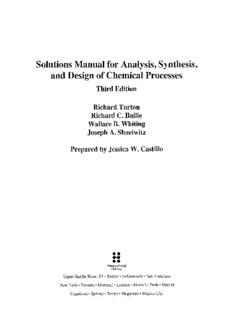
Analysis, Synthesis and Design of Chemical Processes. Solution manual PDF
Preview Analysis, Synthesis and Design of Chemical Processes. Solution manual
Chapter 1 1.1 Block Flow Diagram (BFD) Process Flow Diagram (PFD) Piping and Instrument Diagrams (P&ID) (a) PFD (b) BFD (c) PFD or P&ID (d) P&ID (e) P&ID 1.2 P&ID 1.3 It is important for a process engineer to be able to review a 3-dimensional model prior to the construction phase to check for clearance, accessibility, and layout of equipment, piping, and instrumentation. 1.4 (1) Clearance for tube bundle removal on a heat exchanger. (2) NPSH on a pump – affects the vertical separation of feed vessel and pump inlet. (3) Accessibility of an instrument for an operator – must be able to read a PI or change/move a valve. (4) Separation between equipment for safety reasons – reactors and compressors. (5) Crane access for removing equipment. (6) Vertical positioning of equipment to allow for gravity flow of liquid. (7) Hydrostatic head for thermosiphon reboiler – affects height of column skirt. 1.5 Plastic models are no longer made because they are too expensive and difficult to change/revise. These models have been replaced with virtual/E-model using 3-D CAD. Both types of model allow revision of critical equipment and instrument placement to ensure access, operability, and safety. 1.6 Another reason to elevate the bottom of a tower is to provide enough hydrostatic head driving force to operate a thermosiphon reboiler. 1-1 1.7 (a) PFD or P&ID (b) PFD (c) PFD (d) P&ID (e) BFD (or all PFDs) 1.8 A pipe rack provides a clear path for piping within and between processes. It keeps piping off the ground to eliminate tripping hazards and elevates it above roads to allow vehicle access. 1.9 A structure – mounted vertical plant layout is preferred when land is at a premium and the process must have a small foot print. The disadvantage is that it is more costly because of the additional structural steel. 1.10 (a) BFD – No change PFD – Efficiency changed on fired heater, resize any heat exchanger used to extract heat from the flue gas (economizer) P&ID – Resize fuel and combustion air lines and instrumentation for utilities to fired heater. Changes for design changed of economizer (if present) (b) BFD – Change flow of waste stream in overall material balance PFD – Change stream table P&ID – Change pipe size and any instrumentation for this process line (c) BFD – No change PFD – Add a spare drive, e.g. D-301 → D-301 A/B P&ID – Add parallel drive (d) BFD – No change PFD – No change P&ID – Note changes of valves on diagram 1.11 (a) A new vessel number need not be used, but it would be good practice to add a letter to donate a new vessel, e.g. V-203 → V-203N. This will enable an engineer to locate the new process vessel sheet and vendor information. (b) P&ID definitely PFD change/add the identifying letter. 1-2 1.12 1-3 1.13 (a) (i) Open globe valve D (ii) Shut off gate valves A and C (iii)Open gate valve E and drain contents of isolated line to sewer (iv) Perform necessary maintenance on control valve B (v) Reconnect control valve B and close gate valve E (vi) Open gate valves A and C (vii) Close globe valve D (b) Drain from valve E can go to regular or oily water sewer. (c) Replacing valve D with a gate valve would not be a good idea because we loose the ability to control the flow of process fluid during the maintenance operation. (d) If valve D is eliminated then the process must be shut down every time maintenance is required on the control valve. 1-4 1.14 1.15 1-5 1.16 (a) For a pump with a large NPSH – the vertical distance between the feed vessel and the pump inlet must be large in order to provide the static head required to avoid cavitating the pump. b) Place the overhead condenser vertically above the reflux drum – the bottom shell outlet on the condenser should feed directly into the vertical drum. c) Pumps and control valves should always be placed either at ground level (always for pumps) or near a platform (sometimes control valves) to allow access for maintenance. d) Arrange shell and tube exchangers so that no other equipment or structural steel impedes the removal of the bundle. e) This is why we have pipe racks – never have pipe runs on the ground. Always elevate pipes and place on rack. f) Locate plant to the east of major communities. 1.17 1-6 ⎛ 1 ⎞ 1.17 HT area of 1 tube = πDL=π⎜ ⎟( 12 ft)=3.142 ft2 ⎝ 12⎠ ⎛ 3.2808 ft⎞ 2⎛ 1 ⎞ Number of tubes = (145 m2)⋅⎜ ⎟ ⎜ ⎟ =497 tubes ⎝ m ⎠ ⎝ 3.142 ft2⎠ Use a 1 1/4 inch square pitch ⇒ π⎛ 1 m ⎞ 2 ⎛ m⎞ 2 Fractional area of the tubes = ⎜ ⎟ =0.5027⎜ ⎟ 4⎝ 1.25 in⎠ ⎝ in⎠ A =3 A ∴CSA =4 A VAP LIQ SHELL LIQ ⎛ 497 ⎞⎛ in⎞ 2⎛ π⎞ A =⎜ ⎟⎜ ⎟ ⎜ ⎟( 1 m)2 =777 in2 LIQ ⎝ 0.5027⎠⎝ m⎠ ⎝ 4⎠ π CSA =(4)(777)=3108 in2 ⇒ D2 =3108 in2 SHELL 4 SHELL (4)(3108 in2) D = =62.9 in=1.598 m SHELL π Length of Heat Exchanger = (2+12+2) ft =16 ft =4.877 m Foot Print =1.598×4.877 m 1-7 1.18 From Table 1.11 towers and reactors should have a minimum separation of 15 feet or 4.6 meters. No other restrictions apply. See sketch for details. 1-8
Description: